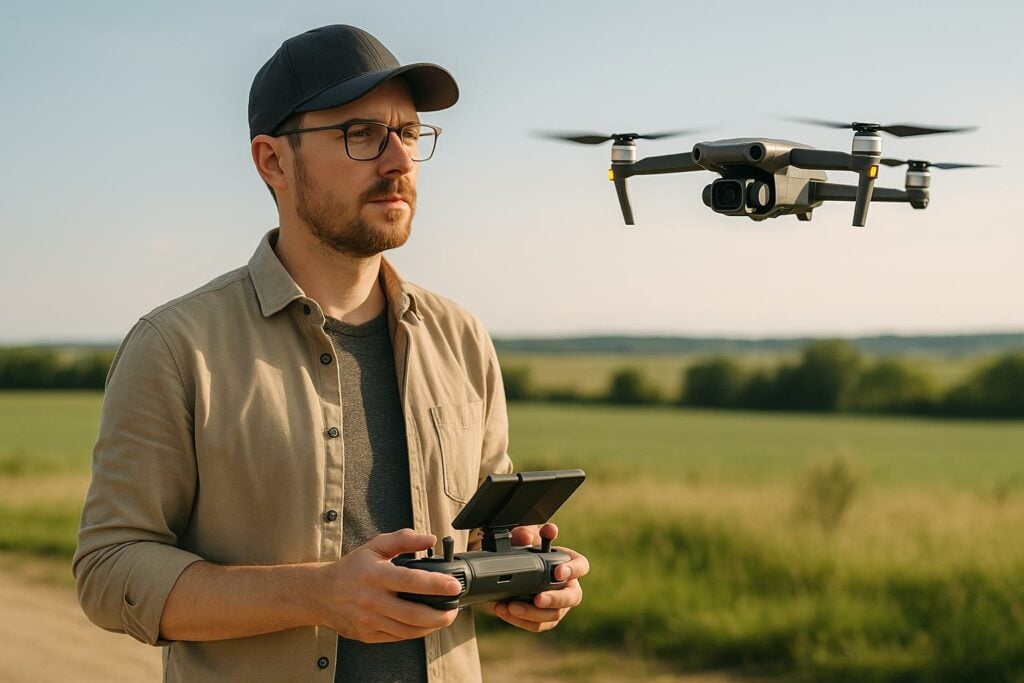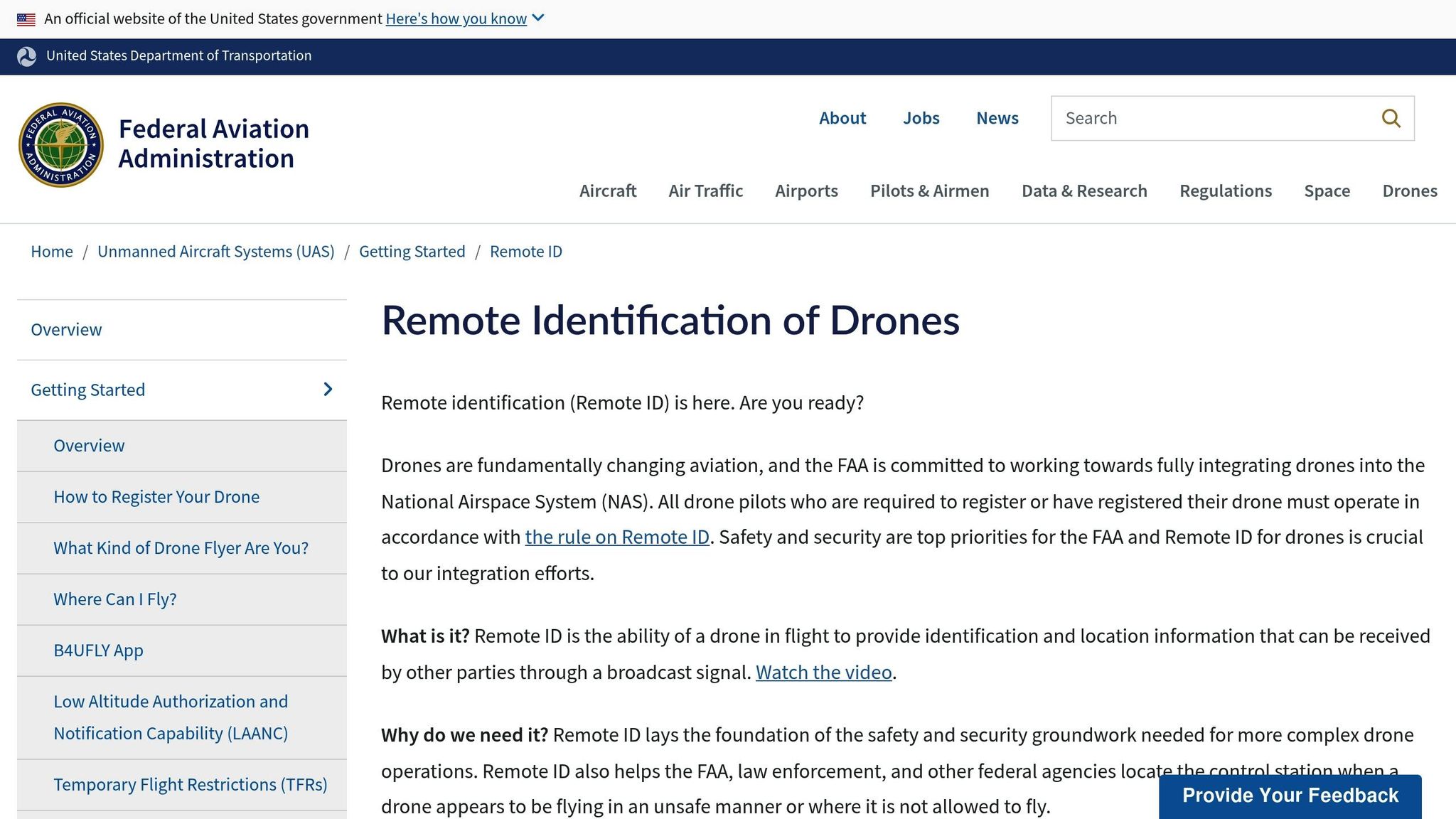Want to legally fly drones for business in the U.S.? The FAA Part 107 certification is your required license to operate drones weighing under 55 pounds for commercial purposes. This certification ensures you understand airspace rules, safety protocols, and operational guidelines. Here’s a quick overview of how to get certified:
- Eligibility: Be at least 16 years old, able to read/speak English, and physically fit to operate a drone.
- Steps to Certification:
- Pass the FAA Aeronautical Knowledge Test.
- Submit your application via the FAA’s IACRA system.
- Key Test Topics: Airspace classifications, weather interpretation, FAA regulations, sectional charts, and drone performance.
- Renewal: Complete online recurrent training every 24 months.
Stay compliant with FAA rules, including drone registration and Remote ID requirements, to avoid penalties. If you’re short on time, services like HomeJab connect you with certified drone pilots for professional aerial photography.
This guide walks you through everything you need to know to earn and maintain your certification.
Get Your Drone License in 2025: Step-by-Step Guide
Requirements and Prerequisites
Before you can take the FAA Part 107 test and operate in U.S. airspace, you’ll need to meet a few basic requirements.
Age and Citizenship Requirements
You must be at least 16 years old. If you’re a U.S. citizen, no extra documentation is needed. However, non-U.S. residents will need to provide additional proof after passing the test.
Language and Physical Requirements
Being able to communicate in English is a must. This is crucial for understanding air traffic control instructions, regulatory materials, weather reports, and NOTAMs (Notice to Airmen).
You also need to be physically and mentally capable of operating a small UAS safely. While FAA medical certificates aren’t required for drone operators (unlike commercial airline pilots), you’re expected to self-assess your fitness before flying.
Drone Registration and Remote ID Rules
While drone registration and Remote ID compliance are necessary for operating under Part 107, they are not prerequisites for getting your Remote Pilot Certificate. You can take the knowledge test and obtain your certificate before registering your drone. Registration typically happens after you’ve passed the test.
For commercial flights, all drones weighing more than 0.55 pounds (250 grams) must be registered. As of September 16, 2023, Remote ID rules require registered drones to broadcast their identification during flight unless operated in an FAA-Recognized Identification Area (FRIA).
If you’re a real estate professional using services like HomeJab for aerial photography, it’s critical to understand and follow these registration and Remote ID requirements to stay compliant with the law.
How to Get Your Certification
To earn your FAA Part 107 certification, you’ll need to complete two key steps: pass the FAA Aeronautical Knowledge Test and submit an online application. Once you’ve passed the test, follow the outlined online process to obtain your Remote Pilot Certificate.
Taking the Knowledge Test
Start by scheduling your knowledge test with an FAA-approved testing provider. This exam will assess your grasp of essential topics like airspace regulations, weather conditions, and flight operations. Keep in mind, the score certificate you receive after passing the test is not your certification – it’s just proof that you passed. Once you have your passing score, move on to the next step without delay.
After the Exam: Application Process
After successfully completing the test, head to the FAA’s IACRA system to finalize your application. Create or log into your IACRA account, choose “Pilot” as the Application Type, and then select “Remote Pilot – Initial” under Pilot Certifications. From there, fill out FAA Form 8710-13, which is the Airman Certificate and/or Rating Application. Once all the required steps are completed, your official Remote Pilot Certificate will be issued.
Test Preparation Guide
Getting ready for the FAA Part 107 test requires a solid strategy. This exam covers a broad range of aviation-related topics, so knowing what to focus on and how to approach your study plan can make a big difference. Here’s a breakdown of the key areas you need to master and the best resources to help you succeed.
What to Study
The Part 107 knowledge test is designed to ensure commercial drone pilots have a firm grasp of essential aviation concepts. Here’s what you need to focus on:
Airspace Classifications
Understanding airspace is a cornerstone of the exam. You’ll need to know the differences between Class B, C, D, E, and G airspace, as well as special use areas like restricted or prohibited zones. Be sure you can identify these on sectional charts and understand the operating rules for each.
Weather Interpretation
This is a tricky area for many test-takers. You’ll need to interpret METARs (Meteorological Aerodrome Reports) and TAFs (Terminal Aerodrome Forecasts), recognize hazardous conditions like microbursts or wind shear, and determine when weather makes drone operations unsafe. The test will challenge your ability to translate weather data into actionable decisions.
Federal Aviation Regulations
A significant portion of the test focuses on Part 107 rules. You’ll need to know operational limits like the 400-foot AGL altitude cap, visual line-of-sight requirements, daylight-only operations, and safe distances from people and property. Additionally, understanding how to apply for waivers and when they’re needed is crucial.
Sectional Chart Reading
Expect to encounter questions requiring you to read and interpret sectional charts. These questions might ask you to identify airports, airspace boundaries, terrain features, or obstacles. Familiarity with the symbols, colors, and notations on these charts is a must.
Aircraft Performance and Loading
Even though the test is drone-specific, some general aviation principles still apply. You’ll need to understand how factors like weight, balance, and environmental conditions impact drone performance, as well as basic aerodynamics.
Study Materials and Resources
The right resources can make your preparation more effective. Here are some tools to help you cover all the bases:
- FAA Remote Pilot Study Guide: This free guide from the FAA is your go-to resource. It’s comprehensive and covers everything you’ll need for the test.
- Practice Tests: Online practice exams simulate the test environment and help pinpoint areas where you need improvement. Taking multiple practice tests can boost your confidence and help you prepare for the question format.
- Online Courses: Many platforms offer structured courses with video lessons and interactive content. These courses break down complex topics and often include practice questions to reinforce your learning.
- Sectional Chart Trainers: Interactive tools designed to improve your chart-reading skills are invaluable. Since these questions are common on the test, practice is essential.
- Pilot’s Handbook of Aeronautical Knowledge: While not drone-specific, this handbook provides deeper insights into aviation concepts, giving you a stronger foundation for the material covered in the exam.
Using Professional Services like HomeJab
If your schedule doesn’t allow for studying, there’s another option to consider. For real estate professionals who need aerial photography but don’t have time to get certified, HomeJab offers a practical solution.
HomeJab connects you with certified drone pilots who are already Part 107 certified. This ensures compliance with FAA regulations while delivering high-quality aerial photography tailored to real estate needs.
sbb-itb-82c5f45
Keeping Your Certification Current
Once you earn your Part 107 certification, staying compliant isn’t a one-and-done process. You’ll need to renew your training, stay informed about regulatory updates, and keep thorough records to ensure everything runs smoothly.
Renewal Training Every 2 Years
Your Part 107 certificate is valid for 24 months. To renew it, you’ll need to complete a 2–3 hour online recurrent training course. This course covers critical topics like airspace regulations, weather, emergency procedures, and any recent changes to the rules. Once completed, you can renew your certification through the FAA’s IACRA system.
Staying Updated on Rule Changes
The drone industry is always evolving, and the FAA frequently revises its rules to keep up with new technology and operational demands. Two recent changes have had a significant impact on Part 107 operations:
- Remote ID Requirements: As of September 16, 2023, all registered drones must broadcast identification and location data. By 2025, every registered drone must comply with these rules, either by having built-in Remote ID capabilities or by using an external Remote ID module.
- Expanded Operational Permissions: Part 107 now allows for night flights, operations over people, and flights over moving vehicles without needing specific waivers. However, night flights in controlled airspace below 400 feet still require airspace authorization.
To keep up with these and other changes, consider signing up for the FAA’s UAS email updates and regularly checking the “Hot Topics in UAS” section on the FAA website. These resources provide the latest safety news, regulatory updates, and other essential information.
Record Keeping Best Practices
Keeping accurate and detailed records is just as important as staying current with training and regulations. The FAA requires Part 107 pilots to maintain records of maintenance and repairs, which must be available for inspection upon request.
Here’s what to include in your records:
- Date of maintenance
- Description of work performed
- Technician’s name and signature
- Drone registration details
These records should be kept for at least 12 months or for the life of the drone. Neglecting proper record keeping could result in fines, penalties, or even the loss of your certification and drone registration.
For efficiency, consider using a standardized format to document maintenance activities as they happen. Digital tools like spreadsheets or maintenance software are great options, but you can also use physical logs or a mix of both. Whichever method you choose, make sure to back up your records regularly and review them for accuracy. Not only does this ensure compliance, but it can also help with troubleshooting and even boost your drone’s resale value down the line.
Conclusion
Getting your Part 107 certification involves meeting the eligibility requirements, passing the aeronautical knowledge test, submitting your application through IACRA, and clearing the TSA background check. Once certified, you’ll be part of a fast-growing industry, with upcoming changes like the anticipated Part 108 for beyond visual line of sight operations expected to open up even more commercial opportunities.
To maintain your certification, you need to complete recurrent training every 24 months and stay informed about regulatory updates, such as Remote ID requirements. With the drone industry advancing quickly, staying compliant is crucial to keeping your certification active.
For real estate professionals, this certification offers the ability to legally capture stunning aerial media. It not only ensures compliance with FAA regulations but also unlocks advanced capabilities to elevate your property marketing. Operating without certification, however, can result in steep fines and significant legal risks.
If you don’t have the time or resources to get certified yourself, you can rely on services like HomeJab, which connects you with certified drone pilots. These professionals deliver compliant, high-quality aerial media that can make your listings stand out. By prioritizing compliant drone operations, you enhance your marketing efforts, minimize legal risks, and gain access to tools that help your properties shine in today’s competitive real estate market.
FAQs
What’s the difference between flying a drone recreationally and commercially under FAA Part 107 rules?
The key distinction between these types of drone use lies in their purpose. Recreational flying is all about personal enjoyment or pursuing a hobby, and it doesn’t require a license. On the other hand, commercial flying involves using a drone for business or profit, which means you’ll need to obtain an FAA Part 107 certification.
Commercial drone pilots must adhere to stricter rules, such as keeping the drone within their visual line of sight, registering their equipment, and following specific operational guidelines. Recreational users, while not bound by these exact requirements, are still expected to follow basic safety practices and ensure their flights remain purely for non-commercial activities.
What’s the best way to prepare for the FAA Part 107 Aeronautical Knowledge Test?
To get ready for the FAA Part 107 Aeronautical Knowledge Test, start by diving into the FAA’s official study materials. The Airman Certification Standards (ACS) for Unmanned Aircraft Systems is a great starting point, covering crucial topics like airspace classifications, weather patterns, and drone safety rules.
Beyond that, consider exploring online resources to reinforce your learning. Look for video tutorials, practice tests, and study guides tailored to Part 107. These often break down key areas, such as reading sectional charts, understanding drone maintenance, and handling emergency situations. Regular practice with sample questions can go a long way in building your confidence for test day.
What do the new FAA Remote ID rules mean for commercial drone operators?
FAA’s Remote ID Rules: What You Need to Know
Starting September 16, 2023, the Federal Aviation Administration (FAA) implemented new Remote ID rules for drones. Think of Remote ID as a digital license plate – it broadcasts the drone’s identification and location while it’s in the air. These rules apply to most drones operating outside FAA-Recognized Identification Areas (FRIAs).
If you’re a commercial drone operator, you’ll need to comply by March 16, 2024. Failing to meet this deadline could result in fines or even the suspension of your pilot certification. The goal of these rules is straightforward: to enhance airspace safety while shaping the way drone operations are managed across the U.S.














